Chinese Journal of Tissue Engineering Research ›› 2022, Vol. 26 ›› Issue (6): 973-979.doi: 10.12307/2022.188
Previous Articles Next Articles
Internal fixation failure after proximal femoral nail antirotation: causes and reoperation strategies
Zhang Xinlong, Ci Wentao, Luo Kaiwen, Yan shi
- Department of Orthopedic Trauma, Affiliated Hospital of Chengde Medical College, Chengde 067000, Hebei Province, China
-
Received:2021-05-10Revised:2021-05-12Accepted:2021-06-09Online:2022-02-28Published:2021-12-08 -
Contact:Yan Shi, Chief physician, Master’s supervisor, Department of Orthopedic Trauma, Affiliated Hospital of Chengde Medical College, Chengde 067000, Hebei Province, China -
About author:Zhang Xinlong, Master candidate, Department of Orthopedic Trauma, Affiliated Hospital of Chengde Medical College, Chengde 067000, Hebei Province, China
CLC Number:
Cite this article
Zhang Xinlong, Ci Wentao, Luo Kaiwen, Yan shi. Internal fixation failure after proximal femoral nail antirotation: causes and reoperation strategies[J]. Chinese Journal of Tissue Engineering Research, 2022, 26(6): 973-979.
share this article
Add to citation manager EndNote|Reference Manager|ProCite|BibTeX|RefWorks
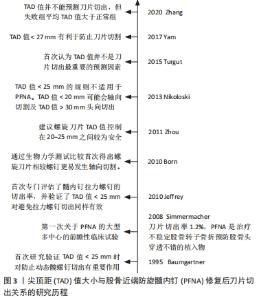
2.1 螺旋刀片切出 2.1.1 螺旋刀片与传统拉力螺钉 螺旋刀片切出是股骨转子间骨折股骨近端防旋髓内钉内固定失效最常见的原因。由于刀片的几何形状与螺钉不同,刀片在负荷情况下发生的移动与螺钉也会不同。BORN等[9]进行了一项关于螺钉和螺旋刀片生物力学的研究比较,用聚氨酯股骨头固定股骨转子间骨折的模型,最后发现相较于螺钉,刀片设备更容易发生轴向移动,最终向内侧切割股骨颈,有研究对临床螺旋刀片发生高切出率的解释与之一致[10-11]。原因与股骨近端防旋髓内钉刀片的轴向接触面有关,其轴向接触面仅为gamma 3螺钉的1/4,向内侧的迁移阻力小,螺旋刀片更易发生轴向移动,当刀片靠近软骨下骨约10 mm时,有可能导致内侧穿孔或轴向切割[12]。张雨等[13]对不稳定转子间骨折Meta分析显示髓内钉切出率为0.76%-3.18%,YAM等[14]临床报道螺旋刀片切出发生率为6.7%,以下为螺旋刀片切出的常见原因: 2.1.2 螺旋刀片放置位置 近年来临床上普遍采用2种螺旋刀片放置位置:一种为螺旋刀片在X射线下的正侧位均位于股骨头中心位置,简称 C/C;另一种为螺旋刀片在X射线下的正位位于股骨头下 1/3 位置,侧位位于股骨头中心位置,螺旋刀片尖距关节线距离应在10 mm以内,如此,即可获得较高的切出阻力,从而减少螺旋刀片在股骨头颈内切割、松动的可能性,简称I/C。但是汤红伟等[15]通过对比 166 例患者螺旋刀片在股骨头中的位置,发现C/C及I/C 两种螺旋刀片放置位置均取得了良好的临床效果,对比差异无统计学意义。BAUMGARTNER等[16]最先提出TAD(尖顶距) < 25 mm时对防止动态髋螺钉切出有重要作用,对于股骨近端防旋髓内钉来说,TAD值作为预测螺旋刀片切出的最重要因素仍存在争议[17]。YAM等[14]研究发现TAD < 27 mm是重要的防止切割因素。有研究则认为尖顶距的最优范围应在 20-25 mm,当尖顶距过小时易出现轴向切出,过大时易向头向切出[18-19]。ZHANG等[20]最新研究显示TAD并不能预测股骨近端防旋髓内钉内固定失效。尽管螺旋刀片的最佳置放位置或TAD值目前仍有争议,但大多数研究表明内固定物放置在上方、前方和后方的位置明显有更高的切割风险[20-21],只有少数认为刀片在下后方位置可以起到保护作用[17]。笔者认为刀片在下中位置(I/C)可以为后内侧皮质提供更好的支撑,压实骨折表面,控制近端旋转移位以及获得更短的杠杆臂,降低刀片切出风险,但下后方位置过于靠近股骨后内侧皮质,反而会增大刀片切出风险。若植入后螺旋刀片未置入最佳位置但并未严重偏离,出于对股骨头骨量的保护,不建议采取多次取出螺旋刀片并重新置入刀片的方法,在这种情况下,延迟负重时间或用骨水泥加固螺旋刀片是一种不错的选择。而对于TAD值,由于刀片相较螺钉更易发生轴向切割[9],因此对尖顶距的下限要严格把控,目前,临床医师还是将TAD值控制在20-25 mm较为妥当,未来仍需要大样本统计及临床随访研究来进一步验证TAD值以及刀片放置位置与螺旋刀片切出的关系。TAD值大小与刀片切出关系的研究历程,见图3。"
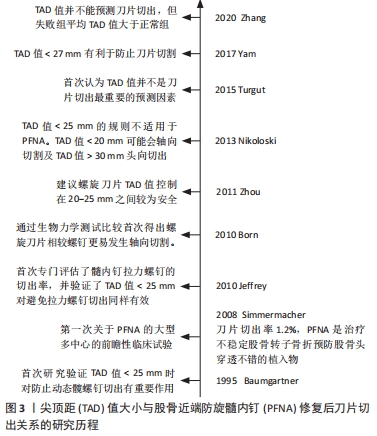
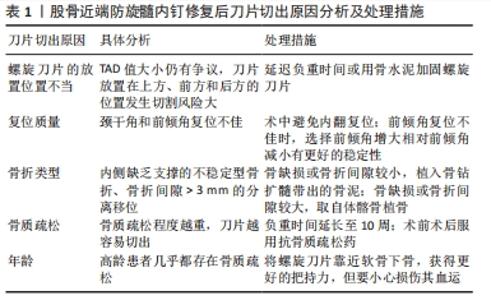
2.1.3 复位质量(颈干角与前倾角) TURGUT等[17]纳入298例患者确认颈干角> 130°是避免螺旋刀片切出的最重要因素,CIUFO等[22]研究发现股骨颈干角的复位失败是刀片切出的危险因素。当骨折内翻复位时,颈干角变小,由于杠杆臂的作用,刀片与股骨头之间会产生更多的作用力,增加螺旋刀片切出的风险,另外值得一提的是,TURGUT等[17]研究表明避免在内翻位置复位骨折以及将螺旋刀片插入适当象限(C/C或I/C),即便TAD值较高,发生刀片切出的概率仍然很低。对于术中难以实现解剖复位的粉碎性股骨转子间骨折,术后其前倾角会发生改变。黄华健[23]通过有限元分析显示术后复位前倾角的增大和减少都会使螺旋刀片与主钉交界处以及周围骨质之间的应力增大,使内固定失败的风险增大。临床医师应强调骨折良好的复位,特别是股骨距处皮质骨的良好接触,避免分离、缺损及阴性接触是预防刀片切出的关键。对于某些术中难以解剖复位颈干角的患者,临床医师都倾向于外翻复位,避免髋部内翻复位。当术中前倾角的改变无法避免时,前倾角增大相对前倾角减小有更好的稳定性。 2.1.4 骨折类型 虽然目前研究者对于不稳定转子间骨折的定义和分类缺乏共识,但大多数以缺乏内侧支撑作为诊断不稳定型骨折的主要标准,且随着内侧粉碎(或碎片大小)的增加而变得越来越不稳定,此外还有少数以外侧壁骨折、大转子骨折等来定义不稳定型骨折[24]。当缺乏内侧支撑时,医生在手术中更趋向于内翻复位不稳定骨折,加上在负重过程中,由于内侧缺损而塌陷为内翻,使得刀片切出率增加。另外,骨折间隙> 3 mm的分离移位也会导致内侧塌陷,使刀片切出的概率增大[22]。对于内侧存在骨缺损或骨折间隙的患者,若骨缺损或骨折间隙较小,可植入骨钻扩髓时带出的骨屑;若骨缺损或骨折间隙较大,术中植入自体髂骨是一个不错的选择。 CIUFO等[22]认为外侧壁破损的严重性要大于其他定义的不稳定型骨折。外侧壁作为股骨干的延续,是股骨近端张力与应力的主要分布点,合并内侧骨折时,外侧壁提供张力侧支撑的作用,此时外侧壁破损会加剧骨折的不稳定性。外侧壁厚度≤20.5 mm容易发生医源性外侧壁破裂,当发生外侧壁骨折时,内固定物承受的应力加倍增大,致螺旋刀片切出率增加[4]。HU等[25]将股骨转子间骨折的外侧壁分为3型:Ⅰ型,外侧壁完整;Ⅱ型,危险型,外侧壁完整,但由于后内侧破损,更容易造成不稳定型骨折;Ⅲ型,外侧壁已破损。Ⅱ,Ⅲ型常作为不稳定型骨折的标志。当外侧壁破损即为Ⅲ型骨折时,即便TAD值在上述所讨论的正常范围内,发生内固定失效的概率仍然很大[26]。因此,对于外侧壁破损严重的患者,单纯使用股骨近端防旋髓内钉并不能保证有良好的手术预后,临床医师往往在外侧壁处加一块纵向钢板,相对单纯应用股骨近端防旋髓内钉的确提高手术疗效,改善髋关节功能,降低卧床并发症[27],但由于外侧壁骨折线也为纵向,且在钢板上打入锁定螺钉时会受到插入的股骨近端防旋髓内钉主钉干扰,致手术难度增加,笔者建议在外侧壁外侧横向打入一块钢板,能有效避免纵向钢板带来的困扰并提高手术疗效。 近年来,张殿英等[28-29]首次提出了“杠杆-支点重建”理论,该理论并不认同传统观点中“内侧壁”与“外侧壁”对于股骨转子间骨折的重要性,其认为骨折后股骨近端的正常解剖结构消失,杠杆失衡致生理支点消失,术后应力也由内、外侧壁转移至内固定物上,采用股骨近端防旋髓内钉固定后并不能同时恢复张力侧及压力侧骨小梁的生理结构,也无法获得正常位置的杠杆支点,因此容易出现内固定物经股骨头切出、髋内翻和退钉等并发症。这一理论为未来设计新型内固定物提供了新的思路,即不要过分计较股骨内外侧壁的完整程度,而要恢复原有的生理支点。 2.1.5 骨质疏松 骨质疏松已被证实是内固定失效的危险因素[5,19]。Singh指数是根据张力骨小梁、压力骨小梁的分布消失的先后顺序分为6级,Ⅳ级以下为骨质疏松。Ⅳ级以下压力骨小梁消失,等级越低,主压力骨小梁逐渐减少或中断,骨质疏松越严重,股骨近端防旋髓内钉治疗的股骨转子间骨折越容易失败[5,30-31],这是因为骨质疏松患者骨小梁本就稀疏,在其微观结构可发现由于骨小梁变少导致相互之间的距离增加,骨小梁的轴向排列减少以及连接不紧密,力学性能下降[32]。当股骨近端受到外力作用时,受力处就会产生“轻微骨折”,当有持续外力作用于股骨近端时,就会导致“轻微骨折”的范围增大,此时稀疏的骨小梁就会发生紊乱,无法提供稳定支撑,从而使内固定失效的概率增大。由于骨质疏松的患者侧壁的“脆弱”,有时,在一些患者中,术前X射线片显示完整的侧壁可能在术中或术后发现破裂[33]。BONNAIRE等[34]研究发现当骨密度< 0.6 g/cm3时,骨折周围缺少足够的把持力来控制螺旋刀片,从而使螺旋刀片发生松动甚至切出。赵晓涛等[1]建议患肢负重时间延长至10周以上或影像学显示骨折愈合为止。骨质疏松程度较严重者术前及术后规范应用抗骨质疏松药物治疗可提高骨密度,降低内固定失效风险。 2.1.6 年龄与性别 高龄也是影响螺旋刀片切出的危险因素[19],李海丰等[35]纳入了年龄> 80岁进行股骨近端防旋髓内钉的患者,证实了TAD为15-20 mm对于高龄患者来说是更好的选择,而不是常规的TAD < 25 mm即可,这是因为高龄患者几乎都存在骨质疏松,骨折处的把持力不如正常骨质,临床上应将螺旋刀片靠近骨密度相对最高的软骨下骨,来获得更好的初始把持力,可以防止刀片切割。当然,当TAD较小时,螺旋刀片更靠近软骨下骨,要更小心损伤其血运。 TSAI等[36]指出女性是Gamma钉内固定螺钉切出股骨头独立危险因素。而目前的研究对于女性是否是股骨近端防旋髓内钉螺旋刀片切出的危险因素并不一致,吴晓天等[19]对股骨转子间骨折髓内固定Meta分析指出女性并非刀片切出的危险因素,而YAM等[14]的研究结果与之相反。关于性别对于刀片切出影响的临床研究,必须要控制年龄变量或将年轻女性和老年女性分开统计研究,因为老年女性由于体内雌激素的减退,更易发生骨质疏松,干扰试验结果。刀片切出原因分析及处理措施,见表1。"
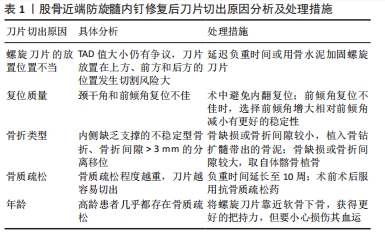

2.2 髋内翻 不稳定骨折常伴有股骨小转子处骨折,股骨转子间骨折闭合复位后,股骨小转子骨折块由于髂腰肌的牵拉往往不能复位,股骨小转子骨折块的不能复位会使股骨距的后内侧出现骨缺损,从而使骨折处失去支持[37],此时,若患者术后负重时间过早,很可能使髋关节内翻畸形。外侧壁较为薄弱或外侧壁破损时,其无法提供张力侧支持,术后易发生髋内翻。髋内翻也常继发于其他类型内固定失效后,螺旋刀片切割股骨头致髋内翻,伴有骨质疏松的不稳定型骨折易发生螺旋刀片退钉,一般会退至主钉与刀片连接处后停止,此时若持续负重,导致髋内翻畸形。对于不稳定型骨折或骨质疏松较为严重的患者,术后应严格限制其髋内收的动作,并延长负重时间。 2.3 骨折不愈合 股骨转子间骨折为关节囊外骨折,其血供丰富,骨折术后发生不愈合的概率较低,但由于中国老龄化人口的增多,术后骨折不愈合的人数逐渐增多,其主要原因可以分为全身因素和局部因素2大方面。全身因素:第一,股骨转子间骨折大多为老年患者,多合并一种或多种内科疾病,多位学者通过研究证实患者合并内科疾病会增加术后内固定失效率[19,38],尤其是合并糖尿病或肾功能不全时,骨折延迟愈合及骨不连大概率增加[6,39];第二,吸烟以及血清白蛋白< 35 g/L会增加手术部位感染的概率[40-42],使患者术后骨折愈合时间延长。局部因素有4点:①手术部位的感染在股骨近端防旋髓内钉修复后是极少见的,一项关于1 941例转子间骨折患者的术后调查显示手术部位感染的发生率为1.3%,其中深部感染0.2%[42],一旦发生感染,骨折周围及骨髓腔被炎症细胞所包围,影响骨折愈合,若感染持续加重,发生慢性骨髓炎导致感染性骨不连,后续的治疗极为复杂。②股骨转子间骨折术前骨折粉碎严重,尤其是不稳定骨折随着内侧粉碎严重而变得越来越不稳定,在手术闭合复位后仍有骨缺损以及骨折分离移位存在,特别是股骨距的后内侧出现骨缺损而未植骨,致螺旋刀片锚合力和抗旋能力减弱,术后骨质不连续致骨折不愈合。③最近研究证实皮质的撞击与骨不连有直接关系[43],原因可能是皮质撞击会限制髓内钉的远端滑动,当远端钉在骨髓腔内的滑动能力受到限制时,会干扰愈合过程中的压缩致骨折延迟愈合或不愈合。④有研究认为远端锁钉的不恰当使用容易使骨折稳定性下降后致骨折延迟愈合或不愈合[44],但最近前瞻性研究发现AO分型的A1和A2型骨折,短髓内钉远端不锁定还是静态或动态锁钉对于骨折愈合都没有影响[45]。对于髓内钉固定后是否使用远端锁钉必须谨慎考虑,在稳定型骨折中,髓内钉固定后,其连续的骨质会分担大部分的压力负荷,使用远端锁钉并不会改变股骨的应力负荷,因此稳定型骨折中似乎没有必要使用远端锁钉。对于复杂的粉碎性不稳定骨折,建议远端静态锁定,若远端不锁定,骨折断端持续加压致骨折移位甚至发生骨折不愈合。 骨折不愈合的原因分类如下:"

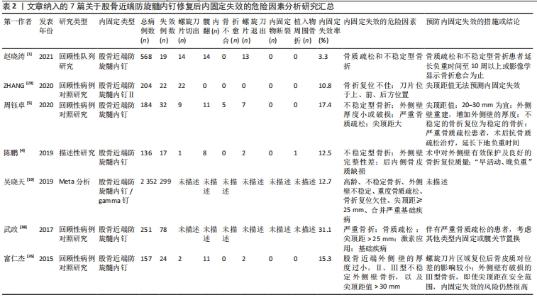
2.4 螺旋刀片退出 螺旋刀片末端采用类似菱形设计,在插入主钉之间后与股骨头、颈部接触连接,可有效减少内固定物发生旋转致螺旋刀片松动及退出,但从设计上来看,股骨近端防旋髓内钉对于螺旋刀片并不是绝对控制。BONNAIRE等[34]研究表明当骨密度< 0.6 g/cm3时,骨折周围缺少足够的把持力来控制螺旋刀片,从而使螺旋刀片发生松动致退出或切割。有学者通过对螺旋刀片松动的三维有限元分析发现术后不可早期负重,以防螺旋刀片松动后退出[46]。在患者进行负重锻炼时,压力会经股骨颈通过螺旋刀片传至远端,应力主要集中于股骨颈负重区域,若患者过早负重,骨折处骨痂尚未形成或患者存在严重骨质疏松,螺旋刀片和周围骨质的锚合力减弱致螺旋刀片松动,最终演变为刀片退出。对于存在高危因素发生股骨近端防旋髓内钉退钉的患者,术中有必要对螺旋刀片用长尾帽固定,术后延长负重时间。 2.5 内固定物断裂 内固定断裂通常发生在螺旋刀片与主钉连接处,发生断裂的原因有很多,通常是因为骨折复位不佳,患者提前负重,髓内钉承受的剪切力过大[47];此外,患者由于局部或全身因素发生感染性或无菌性骨不连,未进行手术干预,持续负重导致内固定物断裂。对于稳定的股骨转子间骨折,在髓内钉植入后会有较为完整的钉-骨接触,无论是否使用远端锁定螺钉,大部分应力均传递到远端骨皮质。当骨折不稳定或髓腔较大的骨折使用远端锁定螺钉时,在缺少皮质接触时,大部分应力会直接传递到锁定螺钉上,致其周围皮质增厚甚至可能发生内固定物断裂[45,48]。除以上因素外,有研究发现亚洲患者的内固定断裂可能还与主钉与髓腔不匹配有关[56,49]。对于一些矮小的亚洲女性,其髓腔明显比正常人窄,更容易出现主钉与髓腔的不匹配,因此,未来设计出更适合亚洲人群的髓内钉类型也是减少内固定失效的一个重要策略。 2.6 植入物周围骨折(股骨骨折) 植入物周围骨折也是股骨近端防旋髓内钉修复后内固定失效的原因之一,笔者将从以下方面分析: 2.6.1 股骨骨折常见部位 短钉固定股骨转子骨折后的股骨骨折大多是股骨远端锁钉处的骨折。 2.6.2 股骨骨折常见人群 患者多数为老年女性患者,主要是由于皮质和髓质的弯曲与年龄、性别有很大的相关性,老年女性的前弓明显更大。 2.6.3 股骨骨折发生的主要原因 ①骨髓腔与髓内钉不匹配:当患者股骨前弓增大、骨髓腔较窄时,在髓内钉进入髓腔时,髓内钉近端与髓腔外侧皮质、髓内钉中部及远端与髓腔的内侧皮质都有可能产生接触,主钉顶在股骨皮质上致股骨干骨折[49]。其次存在髓内钉自身设计问题。为了使髓内钉的尺寸更好的适应亚洲老年人,股骨近端防旋髓内钉Ⅱ在3个方面进行了改进:近端内径缩小至16.5 mm,外翻角缩小至5°以及侧钉表面变平。虽然平坦的侧表面有助于避免髓内钉与股外侧皮质的碰撞[49-50],但TYAGI等[51]通过计算机的断层扫描测定50例亚洲患者股骨近端平均弯曲度,其中80%患者的冠状面平均弯曲度大于5°。因此,当主钉通过大转子处进入股骨时,很有可能会撞击股骨近端外侧壁,导致外侧壁应力增加,骨皮质变薄,发生医源性骨折。②股骨近端防旋髓内钉入钉点位置的偏差:有研究通过对374具尸体的大转子附近入钉点位置研究确认髓内钉应始终在大转子顶点的后方,并建议入钉点在大转子顶点后约0.5 cm处[52]。有研究不同大转子入路点发现相比于大转子的前外侧入路,后内侧入路可以减少对股骨近端外侧壁撞击[53],从而减少医源性骨折的发生。③应力集中:局部应力集中是髓内钉植入后再骨折的主要原因,当远端锁钉紧贴主钉时,会将应力集中在髓内钉的尖端,削弱股骨皮质造成再骨折[54]。④“中裤效应”:短钉相较于长钉更易发生皮质撞击,当髓内钉的长度中等时,由于股骨近中段有前弓存在,髓内钉的远端在髓腔内会顶压股骨致大腿疼痛甚至顶压部位的骨折,即所谓的“中裤效应”。临床上应选择合适长度的主钉,避免“中裤效应”发生。关于股骨近端防旋髓内钉修复后内固定失效的危险因素研究汇总,见表2。"
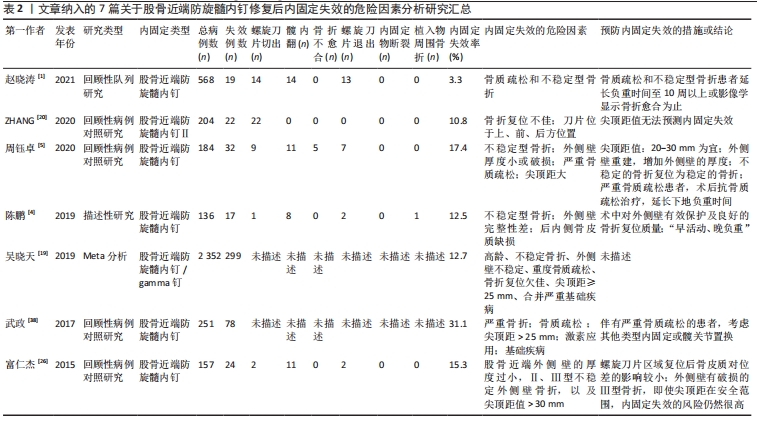
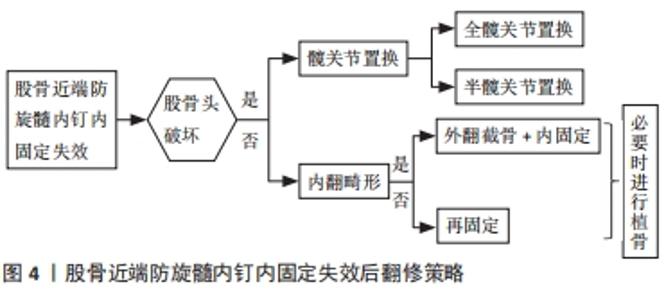
2.7 长钉与短钉选择 对于股骨转子间骨折,长短钉的选择一直是一个关键问题。股骨近端防旋髓内钉一般分为长度< 240 mm 的短钉与> 300 mm的长钉,相较于长钉,短钉手术时间短、出血量少以及创伤小,临床上大多数的股骨转子间骨折都可以用短钉固定,但短钉有更高股骨前皮质撞击率[55],且随着短钉长度(170-240 mm)的增加,皮质撞击发生的概率越大。而长钉通过更加彻底的扩髓与股骨的生理性前弓较为匹配,对于不稳定骨折,为避免局部应力集中致术后内固定物周围骨折而倾向于使用长钉固定。但有研究通过对2 431例病例进行Meta分析,结果显示相较于短钉,长钉并不能使患者术后有更好的预后效果,也不会减少内固定物周围骨折的发生率[56],但其并未对纳入病例的骨折分型以及髓内固定方式进行分类,其结论严谨性不足。作者认为对于一般的股骨转子间骨折,临床医师应尽可能使用170 mm短钉固定,若患者存在严重骨质疏松,建议使用长钉固定;而对于某些特殊类型,如短钉固定术后再次骨折、病理性骨折、A2.3骨折、外侧壁严重骨折以及股骨近端髓腔较大等均应使用长钉固定。 股骨近端髓腔较大的转子间骨折若使用短钉固定,远端锁钉固定后,以远端锁钉为中枢轴点,两侧力臂的差距致近端钉在大髓腔内发生来回摆动。CHANG等[33]指出当钉尖长度小于远端锁钉时,即在170 mm的短钉使用时,近端钉的摆动现象更为严重,影响近端内侧皮质支撑及骨折复位质量。当骨折为AO分型A2.3型时,即骨折线近端粉碎至大转子区域,远端延至小转子下1 cm以上或外侧壁严重骨折时,主钉入口处碎裂严重,且应用短钉时骨折线距离远端锁钉过近,也会出现近端钉来回摆动,术后内固定物的稳定性无法得到保证[57]。 目前,由于股骨反转子间骨折较为少见,对于A3型骨折使用股骨近端防旋髓内钉长、短髓内钉固定疗效的系列报道较少,OKCU等[58]通过前瞻性研究对80例患者随机分组使用长、短钉固定,结果显示长髓内钉治疗A3型转子间骨折在临床疗效上并无任何优势,也没有更低的再手术率。胡建平等[59]的研究结果与之一致。有研究表明短髓内钉较长钉有明显更高的再骨折率[13,60],但他们使用了多种髓内钉类型或是纳入了A2,A3型转子间骨折,使得结果缺乏可靠性。因此,目前关于A3型骨折长、短髓内钉的选择尚未达成共识,是未来骨科医师需要继续探索的一个方向。 2.8 再手术策略 股骨近端防旋髓内钉修复后内固定失败后,颈干角的复位是翻修手术获得成功的关键。目前临床上对于二次手术治疗有较多选择,总体主要包括髋关节置换和髓内外固定术,髓内固定常采用股骨近端防旋髓内钉,髓外固定包括动力髋螺钉和股骨近端锁定钢板等,现以后者的使用居多。有学者以临床使用最高的髓外固定股骨近端锁定钢板与髋关节置换进行股骨近端防旋髓内钉修复后内固定失效的二次手术临床疗效对比[61],显示髋关节置换后的功能恢复较快。闫玉等[62]研究表明对于股骨头质量可、髋关节面情况良好的患者使用股骨近端锁定板可获得满意疗效。何健东等[63]对23例内固定失效患者采取了股骨近端防旋髓内钉内固定或髋关节置换,术后均取得了良好疗效,但样本量过少未进行疗效对比。因此,对于二次手术来说治疗方案的选择尤为重要。一般来说,翻修手术的2种途径是对年轻的骨存量良好的患者进行内固定和对严重骨质疏松和髋关节关节炎的老年患者进行关节置换。 最近的新治疗策略主要是根据股骨头的破坏程度、骨折部位变形情况以及骨缺损3方面来确定[64]。依据此治疗方案,临床和影像学均获得了可靠的结果。当股骨头破坏时,根据患者需求高低选择全髋关节或半髋关节置换。对于股骨头完整的患者,若患者存在内翻畸形,可进行外翻截骨和内固定矫正,但对于已有髋关节炎的患者,不能行截骨手术;若颈干角适合,则对失败的股骨转子间骨折进行再固定。对于有明显骨缺损的患者需进行骨移植,以防术后骨不连,具体治疗策略,见图4。"
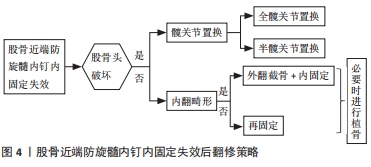
| [1] 赵晓涛,张殿英,郁凯,等.股骨近端防旋髓内钉固定治疗股骨转子间骨折的失效原因分析[J].中华创伤骨科杂志,2021,23(3):202-208. [2] CHENG YX, SHENG X. Optimal surgical methods to treat intertrochanteric fracture: a Bayesian network meta-analysis based on 36 randomized controlled trials. J Orthop Surg Res. 2020;15:402. [3] HAO ZG, WANG XF, ZHANG XQ. Comparing surgical interventions for intertrochanteric hip fracture by blood loss and operation time: a network meta-analysis. J Orthop Surg Res. 2018;13:157. [4] 陈鹏,傅德皓.股骨近端防旋髓内钉治疗老年股骨转子间骨折内固定失败原因分析[J].中国修复重建外科杂志,2019,33(10):1270-1274. [5] 周钰卓,齐宇新,马腾洋,等.老年股骨转子间骨折PFNA失败的危险因素分析[J].中国矫形外科杂志,2020,28(4):292-296. [6] 聂少波,张伟,张里程,等.股骨转子间骨折术后内固定失效的危险因素研究进展[J].中华创伤骨科杂志,2021,23(3):233-238. [7] 石淇允,李无阴,张颖,等.股骨近端防旋髓内钉治疗转子间骨折术后内固定失败因素的研究进展[J].骨科,2020,11(3):262-266. [8] MIN BW, LEE KJ, OH JK et al. Salvage treatment of failed internal fixation of intertrochanteric fractures: what factors determine the failure of treatment? Injury. 2020;51(2):367-371. [9] BORN CT, KARICH B, BAUER C, et al. Hip screw migration testing: first results for hip screws and helical blades utilizing a new oscillating test method. J Orthop Res. 2011;29:760-766. [10] CHAPMAN T, ZMISTOWSKI B, KRIEG J, et al. Helical blade versus screw fixation in the treatment of hip fractures with cephalomedullary devices: incidence of failure and atypical “medial cutout”. J Orthop Trauma. 2018;32:397-402. [11] YAM M, KANG BJ, CHAWLA A, et al. Cephalomedullary blade cut-ins: a poorly understood phenomenon. Arch Orthop Trauma Surg. 2020;140:1939-1945. [12] NIKOLOSKI AN, OSBROUGH AL, YATES PJ. Should the tip-apex distance (TAD) rule be modified for the proximal femoral nail antirotation (PFNA)? A retrospective study. J Orthop Surg Res. 2013;8:35. [13] 张雨,杨旭辉,曾秋铭.长型和短型髓内钉用于不稳定转子间骨折疗效比较的meta分析[J].重庆医学,2020,49(14):2390-2395,2403. [14] YAM M, CHAWLA A, KWEK E. Rewriting the tip apex distance for the proximal femoral nail anti-rotation. Injury. 2017;48:1843-1847. [15] 汤红伟,殷勇.股骨近端防旋髓内钉螺旋刀片的安置位置对临床效果的影响[J].中华创伤骨科杂志,2014,16(2):93-97. [16] BAUMGAERTNER MR, CURTIN SL, LINDSKOG DM, et al. The value of the tip-apex distance in predicting failure of fixation of peritrochanteric fractures of the hip. J Bone Joint Surg Am. 1995;77:1058-1064. [17] TURGUT A, KALENDERER Ö, KARAPINAR L, et al. Which factor is most important for occurrence of cutout complications in patients treated with proximal femoral nail antirotation? Retrospective analysis of 298 patients. Arch Orthop Trauma Surg. 2016;136:623-630. [18] ZHOU JQ, CHANG SM. Failure of PFNA: helical blade perforation and tip-apex distance. Injury. 2012;43:1227-1228. [19] 吴晓天,陈农,何小健,等.股骨转子间骨折髓内固定手术失败危险因素的Meta分析[J].中国骨与关节损伤杂志,2018,33(10):1021-1025. [20] ZHANG W, ANTONY XRP, DECRUZ J, et al. Risk factors for mechanical failure of intertrochanteric fractures after fixation with proximal femoral nail antirotation (PFNA II): a study in a Southeast Asian population. Arch Orthop Trauma Surg. 2021;141:569-575. [21] JIAMTON C, BOERNERT K, BABST R, et al. The nail-shaft-axis of the of proximal femoral nail antirotation (PFNA) is an important prognostic factor in the operative treatment of intertrochanteric fractures. Arch Orthop Trauma Surg. 2018;138:339-349. [22] CIUFO DJ, ZARUTA DA, LIPOF JS, et al. Risk factors associated with cephalomedullary nail cutout in the treatment of trochanteric hip fractures. J Orthop Trauma. 2017;31:583-588. [23] 黄华健.股骨颈前倾角改变对转子间骨折PFNA固定术后的力学稳定性影响的有限元分析[D].广州:南方医科大学,2020. [24] KNOBE M, GRADL G, LADENBURGER A, et al. Unstable intertrochanteric femur fractures:is there a consensus on definition and treatment in Germany? Clin Orthop Relat Res. 2013;471:2831-2840. [25] HU SJ, ZHANG SM, YU GR. Treatment of femoral subtrochanteric fractures with proximal lateral femur locking plates. Acta Ortop Bras. 2012;20:329-333. [26] 富仁杰,徐晓峰,曹兴兵,等.股骨转子间骨折PFNA内固定失效的危险因素分析[J].中国骨与关节损伤杂志,2015,30(6):582-585. [27] 陈志祥,周振宇,刘璠,等.PFNA联合重建锁定钛板治疗累及外侧壁的粉碎性股骨转子间骨折[J].中国骨伤,2018,31(9):840-845. [28] 张殿英,郁凯,杨剑,等.“杠杆-支点平衡”理论-对股骨转子间骨折治疗的新认识[J].中华创伤杂志,2020,36(7):647-651. [29] 张殿英,张晓萌,郁凯,等.重视骨折固定与骨内、外在因素的关系[J].中华肩肘外科电子杂志,2018,6(2):81-84. [30] 黄培镇,陈心敏,郑利钦,等.骨质疏松影响股骨近端防旋髓内钉治疗股骨转子间骨折的有限元仿真[J].中国组织工程究,2020, 24(24):3808-3814. [31] 张兴胜,周方,张志山,等.Singh指数与股骨转子间骨折术后再骨折的相关性研究[J].实用骨科杂志,2019,25(9):786-789. [32] Yu Z,WANG G,TANG T, et al. Long-term effects of ovariectomy on the properties of bone in goats. Exp Ther Med. 2015;9:1967-1973. [33] CHANG SM, HOU ZY, HU SJ, et al. Intertrochanteric femur fracture treatment in asia:what we know and what the world can learn. Orthop Clin North Am. 2020;51:189-205. [34] BONNAIRE F, WEBER A, BOSL O, et al. “Cutting out” in pertrochanteric fractures-problem of osteoporosis? Unfallchirurg. 2007;110:425-432. [35] 李海丰,王华,张英琪,等.头髓钉治疗高龄股骨转子间骨折的尖顶距与螺旋刀片移位的关系[J].中国修复重建外科杂志,2019, 33(10):1234-1238. [36] TSAI SW, LIN CFJ, TZENG YH, et al. Risk factors for cut-out failure of Gamma3 nails in treating unstable intertrochanteric fractures: an analysis of 176 patients. J Chin Med Assoc. 2017;80:587-594. [37] KIM GM, NAM KW, SEO KB, et al. Wiring technique for lesser trochanter fixation in proximal IM nailing of unstable intertrochanteric fractures: a modified candy-package wiring technique. Injury. 2017;48:406-413. [38] 武政,刘向栋,常宝生.PFNA治疗高龄不稳定性股骨转子间骨折内固定失败的危险因素分析[J].局解手术学杂志,2017,26(8):616-619. [39] LODER RT. The influence of diabetes mellitus on the healing of closed fractures. Clin Orthop Relat Res. 1988;(232):210-216. [40] LIANG ZQ, RONG K, GU W, et al. Surgical site infection following elective orthopaedic surgeries in geriatric patients: incidence and associated risk factors. Int Wound J. 2019;16:773-780. [41] MA TX, LU KS, SONG LH, et al. Modifiable factors as current smoking, hypoalbumin, and elevated fasting blood glucose level increased the SSI risk following elderly hip fracture surgery. J Invest Surg. 2020;33:750-758. [42] ZHAO K, ZHANG JZ, LI JY, et al. Incidence and risk factors of surgical site infection after intertrochanteric fracture surgery: a prospective cohort study. Int Wound J. 2020;17:1871-1880. [43] MORI CM, VICENTI G, CARROZZO M, et al. The fake unlocked femoral nail: a configuration to avoid in stable pertrochanteric femur fractures. Injury. 2018;49 Suppl 3:S32-S36. [44] 窦茂鑫,尚剑.老年转子间骨折PFNA固定失败原因的研究进展[J].医学综述,2018,24(1):122-126. [45] CIAFFA V, VICENTI G, MORI CM, et al. Unlocked versus dynamic and static distal locked femoral nails in stable and unstable intertrochanteric fractures. A prospective study. Injury. 2018;49 Suppl 3:S19-S25. [46] 孟广显.PFNA治疗股骨转子间骨折螺旋刀片松动的有限元分析[D].大连:大连医科大学,2015. [47] 李仁斌,林焱斌,庄研,等.股骨近端螺旋刀片抗旋髓内钉治疗股骨转子间骨折的并发症原因分析[J].中国骨与关节外科,2012,5(6): 466-470. [48] YAN WS, CAO WL, SUN M, et al. Distal locked or unlocked nailing for stable intertrochanteric fractures? A meta-analysis. ANZ J Surg. 2020; 90:27-33. [49] SAWAGUCHI T, SAKAGOSHI D, SHIMA Y, et al. Do design adaptations of a trochanteric nail make sense for Asian patients? Results of a multicenter study of the PFNA-II in Japan. Injury. 2014;45:1624-1631. [50] CHANG SM, SONG DL, MA Z, et al. Mismatch of the short straight cephalomedullary nail (PFNA-II) with the anterior bow of the Femur in an Asian population. J Orthop Trauma. 2014;28(1):17-22. [51] TYAGI V, YANG JH, OH KJ. A computed tomography-based analysis of proximal femoral geometry for lateral impingement with two types of proximal femoral nail anterotation in subtrochanteric fractures. Injury. 2010;41:857-861. [52] FARHANG K, DESAI R, WILBER JH, et al. An anatomical study of the entry point in the greater trochanter for intramedullary nailing. Bone Joint J. 2014;96-B(9):1274-1281. [53] PAN S, LIU XH, FENG T, et al. Influence of different great trochanteric entry points on the outcome of intertrochanteric fractures: a retrospective cohort study. BMC Musculoskelet Disord. 2017;18:107. [54] 滕林,肖永川,钟刚.股骨转子间骨折髓内钉内固定术后内植物周围再骨折的治疗[J].中国修复重建外科杂志,2021,35(3):312-317. [55] NIE S, LI M, LI J, et al. Risk factors for anterior cortical impingement of short cephalomedullary nail in chinese elderly patients with intertrochanteric fracture. Ther Clin Risk Manag. 2020;16:523-530. [56] ZHANG Y, ZHANG S, WANG S, et al. Long and short intramedullary nails for fixation of intertrochanteric femur fractures (OTA 31-A1, A2 and A3): a systematic review and meta-analysis. Orthop Traumatol Surg Res. 2017;103(5):685-690. [57] 范振宇,丁晨,葛鑫宇,等.远端第四点固定因素在髓内钉治疗不稳定型股骨转子间骨折中的作用[J].第二军医大学学报,2020, 41(1):18-23. [58] OKCU G, OZKAYIN N, OKTA C, et al. Which implant is better for treating reverse obliquity fractures of the proximal femur:a standard or long nail? Clin Orthop Relat Res. 2013;471(9):2768-2775. [59] 胡建平,李俊峰,秦鸿雁,等.长短髓内钉治疗老年股骨反转子间骨折的疗效比较[J].中华老年骨科与康复电子杂志,2019,5(3):143-148. [60] IRGIT K, RICHARD RD, BEEBE MJ, et al. Reverse oblique and transverse intertrochanteric femoral fractures treated with the long cephalomedullary nail. J Orthop Trauma. 2015;29(9):e299-e304. [61] 刘立云,孙永强,李昂,等.老年股骨转子间骨折股骨近端防旋髓内钉内固定失效后钢板固定和关节置换的疗效比较[J].中华创伤杂志,2020,36(6):496-502. [62] 闫玉,范亚一,李伟伟,等.解剖锁定钢板内固定联合自体髂骨植骨治疗股骨转子间骨折钉板系统内固定失败[J].中国骨与关节损伤杂志,2019,34(4):386-387. [63] 何健东,梁笃,李保林,等.股骨转子间骨折使用股骨近端髓内钉内固定术后失败的翻修策略[J].实用医学杂志,2019,35(7):1032-1035. [64] MIN BW, LEE KJ, OH JK, et al. The Treatment strategies for failed fixation of intertrochanteric fractures. Injury. 2019;50(7):1339-1346. |
| [1] | Wu Zhonghan, Xu Xinzhong, Zhang Jisen, Zhao Yao, Ye Shuming, Yu Shuisheng, Sun Jian, Jing Juehua. One-stage reconstruction of the lateral wall of comminuted reverse oblique intertrochanteric fractures: how to improve the biomechanical stability of bone after repair [J]. Chinese Journal of Tissue Engineering Research, 2021, 25(36): 5838-5843. |
| [2] | Qiu Wei, Lian Xingye. Effect of zoledronic acid on bone mineral density and bone metabolism markers in elderly patients with osteoporotic intertrochanteric fracture after hip arthroplasty: 2-year follow-up [J]. Chinese Journal of Tissue Engineering Research, 2021, 25(33): 5265-5272. |
| [3] | Zhang Tianyi, Mao Kaige, Dong Wei, Li Lixin, Kong Fanlin, Zhu Jun, Fan Guofeng. Which is more suitable for conversion to hip arthroplasty after failure of dynamic hip screws or proximal femoral nail anti-rotation for stable intertrochanteric fractures in the elderly? [J]. Chinese Journal of Tissue Engineering Research, 2021, 25(33): 5335-5340. |
| [4] | Lü Jiaxing, Bai Leipeng, Yang Zhaoxin, Miao Yuesong, Jin Yu, Li Zhehong, Sun Guangpu, Xu Ying, Zhang Qingzhu. Evaluation of internal fixation with proximal femoral nail antirotation in elderly knee osteoarthritis patients with femoral intertrochanteric fractures [J]. Chinese Journal of Tissue Engineering Research, 2021, 25(3): 391-396. |
| [5] | Pan Dongxu, Yang Jing, Li Yaohua, Liu Yuzhang, Duan Yonggang, Zhong Aiyun, Tang Xiaolong, Ding Yingqi. Proximal humerus locking plate combined with allogeneic bone graft in the treatment of proximal humerus osteoporotic fractures [J]. Chinese Journal of Tissue Engineering Research, 2021, 25(27): 4368-4373. |
| [6] | Wang Hao, Wang Yitao, Lü Zexiang, Li Tengfei, Wang Shaolong, Wang Yehua. Effect of repeated intravenous tranexamic acid in the perioperative period of proximal femoral nail antirotation for femoral intertrochanteric fracture [J]. Chinese Journal of Tissue Engineering Research, 2021, 25(21): 3319-3323. |
| [7] | Tian Kechao, Wang Lei, Tao Yong, Yao Tao. Proximal femoral nail antirotation combined with posteromedial wall reconstruction for the treatment of type A2 intertrochanteric fracture in the elderly [J]. Chinese Journal of Tissue Engineering Research, 2021, 25(21): 3337-3342. |
| [8] | Chen Sheng, Zheng Zhihui, Guan Keli, Li Xiaowu, Cai Peibiao, Chen Haibo, Zheng Xun, Zeng Qingqiang. Safety of reducing nausea and vomiting by intravenous infusion of tropisetron hydrochloride after internal fixation with proximal femoral nail antirotation [J]. Chinese Journal of Tissue Engineering Research, 2021, 25(12): 1869-1873. |
| [9] |
Chen Xinmin, Luo Sijia, Xia Zhuowei, Lin Ziling, Zheng Liqin, Li Musheng.
Bone cement augmented proximal femoral nail antirotation for type A3.3 intertrochanteric femoral fractures in elderly: a finite element analysis [J]. Chinese Journal of Tissue Engineering Research, 2020, 24(27): 4265-4271. |
| [10] | Huang Zhaoguo, Zhang Caiyi, Zhang Qing, Wang Sheng, Wang Shaogang, Li Jun, Tao Zhongliang, Zuo Caihong. Curative efficacy of proximal femoral nail antirotation versus intertrochanteric antegrade nail for treating intertrochanteric fracture in older adults [J]. Chinese Journal of Tissue Engineering Research, 2020, 24(21): 3310-3314. |
| [11] | Yu Dongming, Hu Song, Yang Xiaozhong, Zou Yi, Chen Yong, Hu Bo, Gao Daxin. Tranexamic acid controls postoperative hidden blood loss in senile intertrochanteric fracture [J]. Chinese Journal of Tissue Engineering Research, 2020, 24(21): 3353-3357. |
| [12] | Zheng Liqin, Chen Xinmin, Zhang Biao, Li Musheng, Liang Ziyi, Zheng Yongze, Lin Ziling. Finite element simulation of cut-out failure of proximal femoral nail anti-rotation for intertrochanteric fracture [J]. Chinese Journal of Tissue Engineering Research, 2019, 23(36): 5794-5799. |
| [13] | Zuo Sili. Risk assessment of hemiarthroplasty and internal fixation of proximal femoral nail antirotation for treating hip fractures in older adults [J]. Chinese Journal of Tissue Engineering Research, 2019, 23(28): 4440-4445. |
| [14] |
Che Xianda, Han Pengfei, Gu Xiaodong, Gao Yangyang, Chen Taoyu, Li Pengcui.
Clinical outcomes of SuperPATH approach versus traditional posterior approach in total hip arthroplasty: a meta-analysis
[J]. Chinese Journal of Tissue Engineering Research, 2019, 23(24): 3901-3908.
|
| [15] |
Zhang Qingzhu, Fan Qi, Yin Xuelian, Wang Pengcheng, Hou Jing, Feng Zhen, Shi Litao, Zhang Zhongyan, Li Aihua, Wan Qian .
Comparison of three implants for treating intertrochanteric fractures of cerebral infarction hemiplegia side in older adults
[J]. Chinese Journal of Tissue Engineering Research, 2019, 23(24): 3805-3811.
|
| Viewed | ||||||
|
Full text |
|
|||||
|
Abstract |
|
|||||